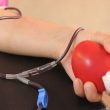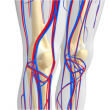In diabetic patients with multivessel disease, anatomical complexity assessed by SYNTAX score is an independent predictor of combined events only por PCI patients, and has absolutely no consequence for surgery. The score should not be used to decide on a revascularization strategy. If the patient is diabetic and has multivessel disease, they simply ought to...
Acute Coronary Syndromes After TAVR: Frequent and Not All Undergo Coronary Angiography
Approximately 10% of patients who undergo transcatheter aortic valve replacement (TAVR) are readmitted for an acute coronary syndrome after a mean follow-up of 25 months. Male sex, prior coronary artery disease, and (surprisingly and hard to explain) nontransfemoral approach were independent predictors of acute coronary syndrome after TAVR, an event associated with high midterm mortality. While...
Continuous Monitoring of Left Atrial Pressure during MitraClip, Regardless Echocardiography
The aim of this study was to assess the use of measuring left atrial pressure to complement transesophageal echocardiography and doppler imaging. Procedure efficacy is measured in the cath lab by echocardiography. However, these measurements are operator dependent and might be influenced by left ventricular function and changes in left atrial compliance. The study...
Radial Access Is Always Preferred, Even for Treatment of the Left Main Coronary Artery
The potential need for a 7-Fr guidewire, the use of several coronary guidewires and/or a kissing balloon, and the requirement of indispensable monitoring by intravascular ultrasound (IVUS) have been used by some interventional cardiologists as excuses to resist radial access. In that sense, left main coronary artery angioplasty was the last stand of femoral access....
Early Strut Coverage and Its Implications for Dual Antiplatelet Therapy
Optical coherence tomography (OCT)-guided drug-eluting stent implantation improves early strut coverage compared with angiography-guided angioplasty. No difference was observed in terms of strut coverage between permanent-polymer everolimus-eluting stents and bioresorbable-polymer biolimus-eluting stents. Short-term dual antiplatelet therapy may be feasible in selected patients with early strut coverage. This study sought to measure early strut coverage...
The Importance of Tibial Artery Patency in the Rechanneling of the Femoral Artery
After rechanneling occluded superficial femoro-popliteal arteries, interventional physicians are left with the question of how to proceed with infrapopliteal disease. This work (soon to be published in Eur J Vasc Endovasc Surg) shows us the importance of achieving patency in tibial arteries so as to obtain better mid-term outcomes. The gist is that, after an...
Predicting Coronary Angioplasty Benefits
Coronary angioplasty or percutaneous coronary intervention (PCI) reduces angina and improves quality of life in patients with stable ischemic cardiomyopathy, though the ORBITA study has shed new light on this. Meanwhile, we will assume this is indeed the case, until new studies either confirm or refute the above mentioned, controversial study. Either way, it is...
Perú Sessions 2018
36th SOLACI Regional Sessions – 12° Andean region. October 25th y 26th 2018 – Lima, Perú. After more than 3 years, SOLACI returns to Lima to carry out the XXXVI edition of the Regional SOLACI Sessions. As always, for SOLACI it implies a great motivation and a stimulating challenge to continue promoting the development of interventional cardiology...
Strategies to Reduce Acute Kidney Injury in Angioplasty
The title of this article leads us to think that we will find a list of things that we can do to reduce kidney injury. However, (unfortunately) sodium bicarbonate showed no benefit over saline and n-acetylcysteine showed no benefit over a placebo for the reduction of kidney damage after coronary angioplasty. Among the protective measures...
Coronary Disease in Diabetes: Diabetic Patients Have Much Greater Plaque Progression
Patients with diabetes mellitus experience significantly greater plaque progression, particularly regarding adverse plaque. Male sex and baseline plaque volume >75% were identified as independent risk factors for plaque progression; the latter actually tripled the risk. This study with tomographic follow-up sought to determine the rate and extent of plaque progression, changes in plaque features, and...








